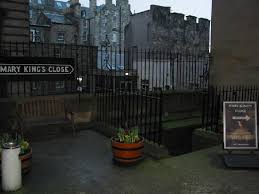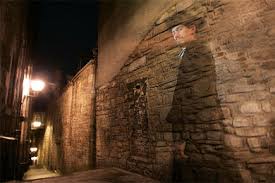Edinburgh is built on the spine of rock. There were a series of lanes and dwellings that grew out of this long street that fell away to either side. Old town made these residences on CLOSES. So a Close was named after the most prominent citizen or resident on the Close.
In the 1630, Mary King Close was a widow and mother of 4 children. She traded fabrics and sewed to make a living. She was highly regarded to have a Close named after her as women did not normally receive this acclaim.
The Closes are now underground. Closes were at the heart of Edinburgh busiest streets. So how 400 years later are they underground?
There are tales of murder, ghosts and 300 plague victims being walled up to die that are waiting to be told.


No pictures were allowed because the government buildings are above the close.


.

Tour guides in period costumes.

When people were being treated from the plague the doctor would wear an oil cloth to protect him and the beak nose mask was filled with sweet smelling herbs believed to keep the evil spirit of the plague away. From most historical accounts, it did work. There is no accurate death toll from the plague in Edinburgh in 1645. In Leith which is like a suburb over 3,000 people died which was roughly 50% of their population. Edinburgh has a population of 35,000 at that same time period.









































